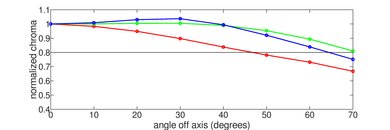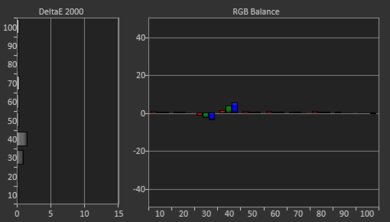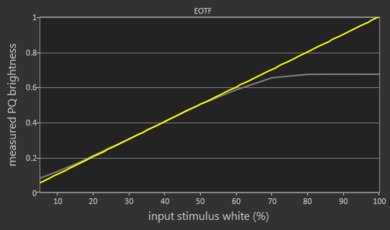The Sony A8G OLED is an excellent 4k TV. Like all OLED TVs, it delivers outstanding dark room performance, thanks its ability to produce perfect blacks and perfect black uniformity. It also has a nearly-instantaneous response time, delivering crystal-clear motion with almost no noticeable blur behind fast-moving objects. This lack of blur can bother some people, though, as it results in stutter when watching movies or other low frame rate content. Unfortunately, like all OLEDs, there is a possibility of burn-in with static content, and the brightness of the screen changes depending on the content, also known as ABL, which may bother some people.
Our Verdict
The Sony A8G is an excellent TV for almost any usage. It has great viewing angles and outstanding reflection handling, so it looks great in almost any room. Like all OLEDs, though, it truly shines in a dark room, thanks to perfect, uniform blacks. Fast-moving objects in games and movies look great, due to the nearly-instantaneous response time, but this results in more stutter, which is especially noticeable when watching movies.
-
Excellent dark room performance.
-
Outstanding low motion blur.
-
Image remains accurate when viewed at an angle.
-
Brightness varies with different content, due to the Automatic Brightness Limiter (ABL).
-
Possibility of permanent burn-in with static content (see here).
The Sony A8G OLED is an outstanding TV for watching movies in a dark room. It looks great in a dark room, thanks to the nearly infinite contrast ratio and outstanding black uniformity. Fast-moving action movies look great, thanks to the nearly-instantaneous response time, which results in very little blur, but this lack of blur may bother some people when watching movies.
This is an excellent TV for watching TV shows during the day. It has outstanding reflection handling and wide viewing angles, great if you like to leave the TV on while you move about, but it might not be bright enough if you have a lot of windows. Cable content looks great thanks to the TV's great upscaling performance, and it has a huge selection of streaming apps, great for cord-cutters.
The TV is an excellent TV for watching sports. It has excellent motion handling, thanks to the nearly-instantaneous response time, so fast-moving objects (or players) look great, with almost no blur behind them. When watching the big game with a group of friends, everyone can enjoy the game thanks to the TV's wide viewing angles. There also shouldn't be any issues in a bright room, due to the excellent reflection handling, but it might not be bright enough to overcome glare in a really bright room.
This is an excellent TV for video games, mainly due to the outstanding picture quality. Games look great thanks to the deep, uniform blacks and nearly-instantaneous response time, so there is no blur behind fast-moving objects. Unfortunately, the A8G has higher-than-average input lag, and isn't ideal for competitive gaming.
The TV is an outstanding TV for watching HDR movies in a dark room. The OLED panel delivers deep, inky blacks, with perfect uniformity. Subtitled movies look great, with no blooming around subtitles. The TV has a nearly-instantaneous response time, so there is very little blur behind fast-moving objects, but this lack of blur may bother some people, especially when watching movies. Finally, it can display an excellent wide color gamut, but can't get bright enough in HDR for some content.
This is an excellent TV for gaming in HDR for most people. It has a nearly-instantaneous response time, so fast-moving objects in your favorite games look extremely clear, with no blur. It also looks amazing gaming in a dark room, thanks to the perfect blacks, and perfect black uniformity. Unfortunately, it has higher-than-average input lag, which isn't ideal for competitive gaming, and it doesn't support any of the variable refresh rate technologies, like FreeSync.
The TV looks great as a PC monitor, but it should be used with care, as long-term exposure to static elements (such as the taskbar or desktop icons) can cause permanent burn-in. It has wide viewing angles and a nearly-instantaneous response time, but unfortunately, it has higher-than-average input lag, which may bother some people. We also encountered an issue when the TV is sent a 4k signal, with chroma 4:4:4 or RGB, which isn't ideal for desktop use.
- 8.5 Mixed Usage
- 9.4 Movies
- 8.1 TV Shows
- 8.6 Sports
- 7.9 Video Games
- 8.7 HDR Movies
- 7.9 HDR Gaming
- 8.0 PC Monitor
Changelog
- Updated May 21, 2020: Converted to Test Bench 1.5.
- Updated Feb 21, 2020: Converted to Test Bench 1.4.
- Updated Jul 19, 2019: The A8G has been updated to Android 8.0. We have retested the smart features and updated the scores and text.
- Updated Jun 21, 2019: Review published.
- Updated Jun 19, 2019: Our testers have started testing this product.
Check Price
Differences Between Sizes And Variants
We tested the 55" A8G (XBR55A8G), and we expect our results to be valid for the 65" (XBR65A8G) as well.
If someone comes across a different type of panel or if their Sony OLED A8G doesn't correspond to our review, let us know and we will update the review. Note that some tests such as the gray uniformity may vary between individual units.
| Size | US Model | Alternative Name | EU Model |
| 55" | XBR55A8G | XBR-55A8G | XBR55AG8 |
| 65" | XBR65A8G | XBR-65A8G | XBR65AG8 |
The A8G we reviewed was manufactured in April 2019.
Popular TVs Comparisons

The A8G is a great OLED TV, but lacks most of the new features found on newer Sony TVs. See our recommendations for the best OLED TVs, the best televisions on the market, and the best smart TVs.
The Sony A8H OLED is marginally better than the Sony A8G OLED for most uses. The A8H got a few improvements over its predecessor. It has a higher SDR and HDR peak brightness, has better pre-calibration color accuracy, and its input lag is much lower, making it a better option for gaming. The A8G has slightly better viewing angles, but not by much.
Other than the design changes, there is almost no difference between the Sony A8F OLED and Sony A8G. The A8G has slightly worse sound, but most people won't notice this, and it's slightly less bright in HDR than the A8F, but this could vary between units.
The LG C9 OLED is a bit better than the Sony A8G. The C9 supports many new technologies, including HDMI 2.1 on all four HDMI ports, as well as eARC, and HDMI Forum's new variable refresh rate technology, great for Xbox One gamers. The C9 also has significantly less input lag, which is great for gaming or use as a PC monitor.
The Sony X950G and Sony A8G use different panel technologies, each with their own advantages and disadvantages. The X950G uses a VA panel, which is much brighter. The X950G also has much lower input lag, supports newer formats, including eARC, and supports the full bandwidth of HDMI 2.0 over all four HDMI ports. The A8G, on the other hand, looks much better in a dark room, has clearer motion with no blur, and has incredibly wide viewing angles. Unfortunately, the A8G also has a chance of permanent burn-in, although we don't expect this to be an issue for most people.
The Sony A8G OLED is a marginally better TV than the Samsung Q80R. The OLED has a faster response time and has perfect blacks thanks to its OLED panel that turns each pixel on and off individually. On the other hand, the Samsung can get much brighter, has a wider color gamut, much lower input lag, and is more accurate out of the box. The OLED also has the risk of permanent burn-in, though this is unlikely with regular use.
The Sony A9G OLED is very similar overall to the Sony A8G, but is a bit better for gaming. The A9G has much lower input lag, and all four HDMI ports support the full bandwidth of HDMI 2.0. The A8G only supports ARC over HDMI, whereas the A9G supports eARC, which allows for new, higher quality audio formats. The A9G also has a better remote, and the smart features are smoother and faster, due to the inclusion of a better smart processor.
The LG B9 OLED is a bit better than the Sony A8G OLED. The B9 has HDMI 2.1 on all four HDMI ports, as well as eARC. The B9 is better for gaming as it has a much lower input lag and supports HDMI Forum's new variable refresh rate technology, which is great news if you have an Xbox One.
Overall, the Samsung Q90T QLED performs about the same as the Sony A8G OLED. That said, these two TVs are wildly different, as the Sony is an OLED that can produce perfect blacks, while the Samsung is an LED TV that uses backlighting, causing blacks to appear a bit grayish in some scenes. The Samsung can get brighter to deliver a better HDR experience, and it has low input lag as well as FreeSync support. On the other hand, the Sony has much wider viewing angles, and its black and gray uniformity are significantly better.
Video
Test Results
The Sony A8G is a 2019 model OLED TV, and is the direct replacement of last year's A8F. The A8G is Sony's cheapest OLED TV, and is a little bit less feature-packed than the more expensive A9G. The main competitors to the A8G are the LG B9, LG C9, and LG E9. The main LED competitors to the A8G are the Sony Z9F, the Samsung Q90R, and the Samsung Q80R; although all of these are much brighter, they don't perform as well in dark rooms.
The Sony A8G has an excellent design. The overall design language is very simple and minimalist, and is very similar to the A9G and A8F. The stand is simple, but it can be set to two different height positions, depending on the orientation of the stand, which is great if you want to place a small soundbar in front. The stand supports the TV extremely well, but it does wobble a bit when nudged. The TV appears to be extremely well-built, and there shouldn't be any issues with it.
Update 07/18/2019: We modified the text below to include a picture of the alternate stand position.
Update 06/21/2019: We have clarified our text below regarding the stand position.
The stand is very simple, but supports the TV extremely well. Unique to the A8G, the stand can be reversed, as shown above, which leaves a gap of about 2.4" below the TV. With the stand reversed, with the 'U' shape in front, there is no gap between the TV and the stand.
Footprint of the 55" stand: 25.8" x 11.5".
The back of the TV is plain, using the same design language as the A9G, but with a simpler pattern. The back of the feet are hollow, and can be used for simple, but effective, cable management. Unlike the A8F, the entire back of the TV is black.
The TV does not have a local dimming feature, as there is no backlight. As an OLED TV, it can turn off, or dim, individual pixels. This is great for dark room viewing, as it results in no noticeable blooming around bright objects in dark scenes. This is also great if you watch content with subtitles, as they are displayed perfectly, with no blooming around them.
The TV has decent SDR peak brightness, very similar to the A9G and A8F. It's bright enough for most rooms, but in very bright rooms it might not be bright enough, in which case LED TVs like the Samsung Q80R might be a better choice, as they are much brighter.
Unfortunately, like all OLED TVs, the brightness can vary with different content, which may be distracting.
We measured the peak brightness after calibration, using the 'Custom' Picture Mode, with Peak Luminance set to 'High', and Color Temperature set to 'Expert 1'.
If accuracy isn't as important to you, the A8G is able to reach a peak brightness of 700 cd/m² with the 'Vivid' Picture Mode, as measured with the 2% window.
Decent HDR peak brightness. Small highlights can get bright enough to really stick out, which is great, but the TV dims considerably when displaying large bright areas. This change in brightness, also known as ABL, may be distracting with some content.
We measured the peak brightness before calibration, using the 'Cinema' Picture Mode, with Peak Luminance set to 'High', and Color Temperature set to 'Expert 2'.
If accuracy isn't as important to you, the A8G is able to reach a peak brightness of 840 cd/m² with the 'Vivid' Picture Mode, as measured with the 2% window.
The Sony A8G OLED has excellent gray uniformity. There is almost no noticeable dirty screen effect, great for sports fans. In near-black scenes, the uniformity is slightly better, but like all OLED TVs we've tested, there are some very faint horizontal and vertical lines. These can only be seen when displayed near-black scenes in a pitch-black room.
The TV has excellent wide viewing angles. Unlike VA and IPS TVs, there is very little fluctuation in black levels or brightness at wide angles. It isn't perfect, though, as colors gradually lose accuracy, and at wide angles they appear washed out.
This TV has excellent reflection handling, very similar to other top-end Sony TVs. Like many high-end TVs, the anti-reflective coating is very good at diffusing reflections across the screen, but this does add a slight purple tint to the screen.
With our pre-calibration settings, the Sony A8G has decent accuracy. Colors have great accuracy, but there are some inaccuracies that might be noticeable. The white balance is inaccurate, though, and almost all shades of gray have noticeable inaccuracies. Gamma is a bit too low, resulting in most scenes appearing brighter than they should.
Update 09/16/2019: With Android 8.0 it is now possible to download the CalMAN for Bravia app from the app store for Auto-Calibration.
After calibration, the TV has excellent accuracy. Color accuracy improved a bit, and white balance errors were almost completely corrected. Gamma is much closer to the 2.2 reference target.You can see our recommended settings here.
Most 4k content looks great, but there are some noticeable issues when using the A8G as a PC monitor. Find out more here.
Like all OLED TVs, the Sony A8G uses a 4 sub-pixel structure, but all 4 are never used at the same time on one pixel. This image shows the red, green, and white sub-pixels. You can see the blue sub-pixel in our alternative pixel photo.
We encountered an issue when using the A8G connected to a PC. When sending full 4:4:4 chroma or RGB, there appears to be a processing issue affecting the white sub-pixel, which results in non-uniform text. The affected pixels also appeared to move around as we moved our test image around the screen. We took a few photos of the issue to show how it changes over time:
We also posted a video of the effect to YouTube. On our unit, setting the Contrast to '89' instead of '90' corrected most of the issue, but we don't know if this is specific to our unit or not.The Sony A8G, like all OLEDs, can display an impressive wide color gamut. It measures slightly better than the A9G, but this is likely due to panel variance, and is not necessarily indicative of a real difference. The EOTF follows the PQ curve almost perfectly, but some dark scenes are slightly over-brightened. In Game mode, the EOTF is identical (Shown here).
If you find HDR too dim, check out our recommended settings here. With these settings, HDR content appears much brighter on the A8G, as shown here.
Unfortunately, the Sony A8G has mediocre color volume. Like the A9G, the A8G can't display very bright saturated colors, as the white sub-pixel desaturates pure colors at high brightness levels.
This TV does an excellent job displaying gradients. There is some banding in all colors, but it shouldn't be very noticeable with most content. The Smooth Gradation feature can remove almost all remaining banding, but can cause a loss of some fine details.
The TV shows no signs of temporary image retention, but this can vary a bit between units.
This test is only indicative of short term image retention, and not the permanent burn-in that may occur with longer exposure to static images. We are currently running a long-term test to help us better understand permanent burn-in. You can see our results and read more about our investigation here.
Update 11/01/2019: Updated text to include our stance on burn-in.
Although we don't expect most people who watch varied content to have any issues, OLED TVs, such as the Sony A8G do have the possibility of experiencing burn in. The Sony A8G has two features to help mitigate burn-in. Find out more about these options here.You can read about our investigation into this here.
The Sony A8G has an optional Black Frame Insertion feature that can help improve the clarity of motion, by reducing the amount of time the image is held static on screen. The A8G can only do this by introducing a 60Hz flicker, which may bother some people.
This feature can be enabled on the A8G by setting Motionflow to 'Custom', and setting Clearness to 'High'.
The Sony A8G can interpolate lower frame rate content to increase the frame rate as high as 120 fps. In very busy scenes, the TV will sometimes stop interpolating, which can cause the image to appear to jerk, due to the sudden change in frame rate.
See here for the settings that control the A8G's motion interpolation feature.
Like all OLED TVs, 24p content can appear to stutter, due to the nearly instantaneous response time. This is especially noticeable with slow-panning shots. If this bothers you, enabling motion interpolation or the Black Frame Insertion feature can help.
This TV can remove judder from all sources. If the Black Frame Insertion(BFI) feature is enabled, the A8G is unable to remove judder from 24p content played back from a 60p/i source, like a cable box.
See our recommended settings to remove judder here.
Unlike the LG C9, the Sony A8G does not support any of the variable refresh rate technologies, like HDMI Forum's VRR. It does have a native 120Hz panel, which is great for gaming.
The TV has good low input lag, but it is slightly worse than the A8F, and significantly worse than other high-end TVs, including the LG C9. To get the lowest input lag, simply switch to either the 'Game' or 'Graphics' Picture Mode.
If you need a TV with lower input lag for gaming, check out the Sony A8H OLED.
The Sony A8G supports most of the common formats. Chroma 4:4:4 is displayed properly in most formats, except when sending 1440p @ 120Hz, as long as the Picture Mode is set to 'Game' or 'Graphics'. Even though chroma 4:4:4 is displayed properly, there is a processing issue on the A8G that causes a rendering issue when sending a 4k 4:4:4/RGB signal, as described here.
Unlike the X950G and A9G, only HDMI ports 2 & 3 support the full bandwidth of HDMI 2.0.
The Sony A8G supports HDR10 and Dolby Vision, but does not support the competing HDR10+ format. Like the A9G, the headphone jack can also be used to connect to a subwoofer, but unlike the A9G, the TV cannot be used as a center speaker.
If you want an OLED TV with HDMI 2.1 inputs, check out the LG CX OLED.
Unlike the Sony A9G and LG C9, the Sony A8G does not support eARC. Lossy Dolby Atmos is supported through Dolby Digital Plus from native apps, including Netflix.
The frequency response of the Sony A8G is decent. Low-frequency extension (LFE) is at about 80Hz, which is decent, and results in a bass with good body and punch, but no thump. Frequency response above the LFE is well-balanced, resulting in clear dialog, but as it tapers off around 9kHz, it lacks a bit of airiness.
The distortion performance is decent. At low and moderate volumes, there is very little distortion, which is great. At higher volume levels, the total amount of distortion increases significantly. This shouldn't be an issue for most people, though.
Update 07/18/2019: The Sony A8G has been updated to Android 8.0 and the score has been modified to reflect the change. The time to select YouTube has also gone down by 1 second thanks to the easier to navigate menu.
The Android 8.0 interface is easy to use, but not as smooth on the A8G as the A9G, and it is a bit slower overall.
Update 07/18/2019: The Sony A8G has been updated to Android 8.0 and the score has been modified to reflect the change. There are now ads like all other Sonys tested with Android 8.0. It is possible to remove these ads though, with the instructions posted here.
The Sony A8G has the same remote as the A8F, which requires direct line-of-sight for most functions. The remote is quite large, but has dedicated buttons for many of the TV's functions. Once paired over Bluetooth, the remote also works with the TV's voice control features.
Comments
Sony A8G OLED: Main Discussion
Let us know why you want us to review the product here, or encourage others to vote for this product.





























































































